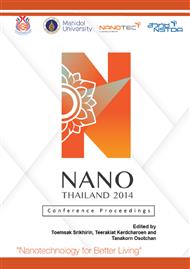p.60
p.64
p.71
p.75
p.79
p.84
p.88
p.97
p.106
Bio-Hybrid Composite Scaffold from Silk Fibroin/Chitosan/Mesoporous Bioactive Glass Microspheres for Tissue Engineering Applications
Abstract:
This research aims to fabricate the novel bio-hybrid composite scaffold from mesoporous bioactive glasses/silk fibroin/chitosan (MBGs/SF/CS) for use in tissue engineering applications. MBGs/SF/CS composite scaffolds were successfully fabricated using freezing and lyophilization process. Two types of mesoporous bioactive glasses which were irregular and spherical shape were dispersed in the silk fibroin/chitosan based scaffolds in order to improve the mechanical strength and bioactivity. SEM observation showed the interconnected pores with pore size from 100 to 300 µm. XRD and FTIR exhibited the present of silk fibroin, chitosan, and MBGs in composite scaffolds. The incorporation of MBGs in SF/CS scaffolds significantly increased the compressive strength of scaffolds. The composite scaffolds were immersed in the simulated body fluid (SBF) for in vitro bioactivity test. The in vitro bioactivity results indicated that the MBGs/SF/CS induced hydroxycarbonate apatite (HCA) formation while there was no change for SF/CS scaffolds. Furthermore, mesoporous bioactive glass with micro-spherical particles (MBGMs) which easily dispersed in SF/CS solution during the fabrication of scaffolds as compared to mesoporous bioactive glass with irregular shape (MBGs). The results showed that MBGs/SF/CS composite scaffolds could be useful composite scaffolds for tissue engineering applications.
Info:
Periodical:
Pages:
79-83
Citation:
Online since:
December 2015
Authors:
Price:
Сopyright:
© 2016 Trans Tech Publications Ltd. All Rights Reserved
Share:
Citation:


